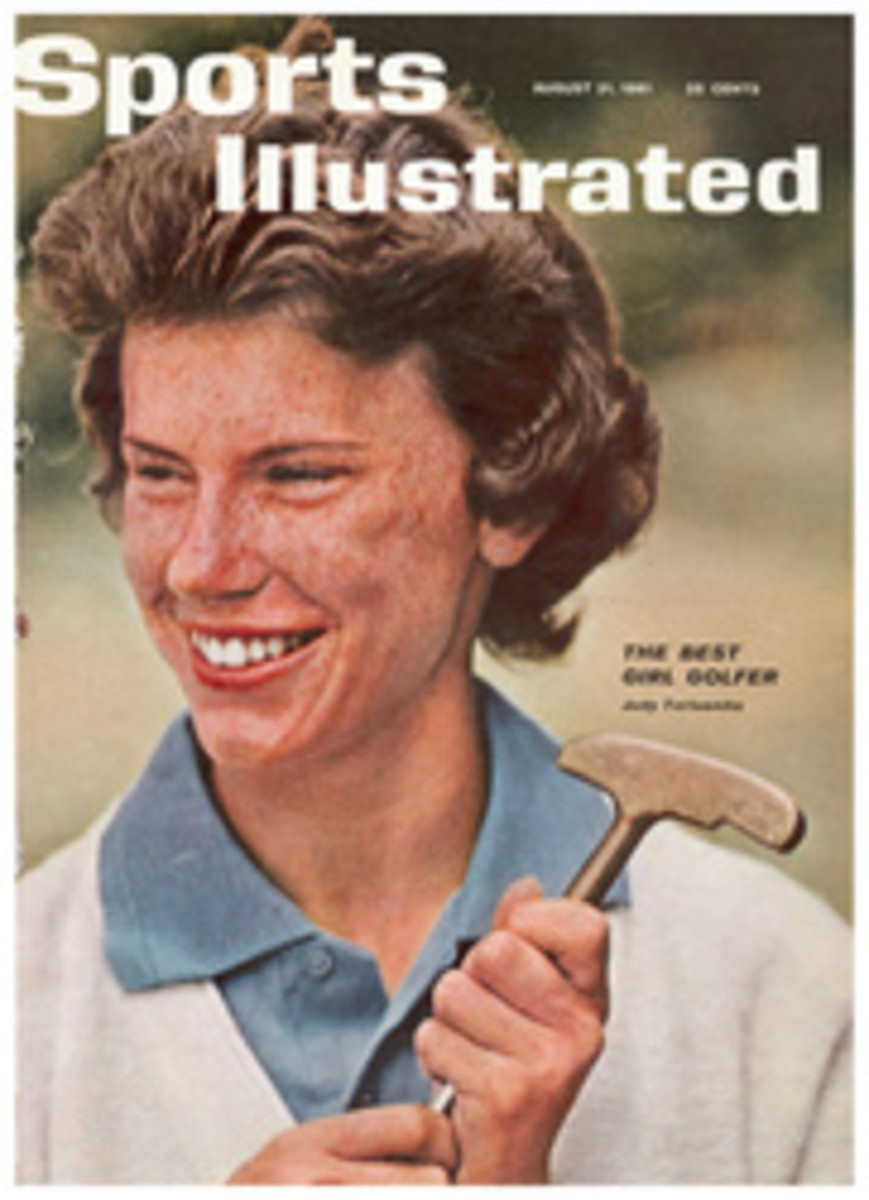
The old champion (age 17) bows out
In the women's swimming championships at Philadelphia last weekend Christine von Saltza, the gentle, mannerly and very powerful 17-year-old who has ruled the chlorinated waters of the world for two years, bowed out of national competition as any woman swimming champion should—by losing all her titles. Each time that von Saltza bobbed her head up out of the froth at the finish—in the 100-meter freestyle, in the 400 meters and in the 200-meter backstroke—there, hanging on the wall in the next lane, she found a panting, grinning 15-year-old home first ahead of her. After her third loss to the 15-year-olds, on the final day of the meet Champion von Saltza scratched from the 200-meter freestyle, graciously surrendering her last (and best) opportunity to strike back at the youngsters so that a teammate would have a better chance to make the women's team that will tour Europe.
For some years now—even before towheaded Chris von Saltza joined the big swim as a gangling 12-year-old in 1956—U.S. swimming has been ruled by youngsters. This year the look of extreme youth showed even in the big smiles of the new champions. The first four winners all wore braces, like irksome badges of adolescence, on their teeth.
To start the assault, Carolyn House of Los Angeles, a sleek youngster with a veteran's remarkable instincts about pace, won the long and tedious 1,500 meters (and subsequently the 400 meters and 200 meters as well). Next, another lesser-known 15-year-old, Robyn Johnson of the Northern Virginia Athletic Club, touched out von Saltza in a cavalry-charge finish in the 100-meter freestyle. Then Jean Ann Dellekamp of Indianapolis, age 14, won the 200-meter breaststroke. Then rosy-cheeked Nina Harmar of Philadelphia, age 15, took the 200-meter backstroke to give the veteran von Saltza her second defeat.
The string of wins by the brace-wearers was finally broken when Donna de Varona, the Olympic veteran, with teeth perfect enough to throw an orthodontist into a fit of despair, won the 400-meter individual medley in 5:34.5, breaking her own world record.
At 17, the mind wanders
Shaking her head over her losses, Dethroned Champion von Saltza confessed, "What it is, I just don't know," And her coach, George Haines of the Santa Clara Swim Club, could do no better than offer a partial answer. "It's the year after the Olympics," he said, "and the incentive is gone. Chris is entering Stanford in the fall, and she has other things on her mind."
Why are most of the winning women barely old enough for high school? In the results at Philadelphia there was a bit more of an answer than Coach George Haines gave. The 14-year-olds and 15-year-olds at Philadelphia had an uncommon and irrepressible urge to win. For the up-and-coming swimmer, a victory over an Olympic champion is, in a certain sense, a way of earning a gold medal in a non-Olympic year. After touching out von Saltza in the 100-meter freestyle and placing second (again ahead of von Saltza) in the 400-meters, newcomer Robyn Johnson said simply, "I wanted to beat Chris very much." With this one thing on her mind, Miss Johnson went out and did it.
The impatience of youth to be served was particularly manifest in the breast-stroke. Last year's 200-meter champion, Ann Warner, did not get into the finals. Jean Ann Dellekamp, the 14-year-old who did win the 200-meter breaststroke, was beaten to the wall the next day in the 100-meter event by a 13-year-old, Dale Barnhard of the Congressional Country Club. Little Miss Upstart Barnhard had barely squeezed into the 100-meter race. She had been obliged to race in a swim-off for the privilege of using the choppy, guttery eighth lane in the finals. Swimmers in the outside lanes are not supposed to win big-time races (and rarely have since the Hungarian Ferenc Osik sneaked by the Americans and Japanese to steal a gold medal at the Berlin Games), but Miss Barnhard, being just a kid, apparently does not know such things. "I guess," she explained, "I was just happy to be in the race."
Donna de Varona, baby of last year's Olympic teams, is finally 14 (she has had fame so long it now seems she was 13 for about three years). Miss de Varona celebrated the passing of another year by taking not only the 400-meter but also the 200-meter medley in record time (2:35.0, an American record, since the 200-meter event is not on the international list). To top it off, she came very close to a third title, barely losing the 100-meter backstroke to 15-year-old Nina Harmar. Though at 14 Miss de Varona is well traveled and has signed more autographs in North America, Asia and Europe than most Americans have checks, she retains the resilience and single-mindedness of a young swimmer not yet jaded by the taste of chlorine or the wonders of the world abroad. The day she swam the 400-meter medley she gashed both legs when a car door closed on them. Coach Haines, ordinarily a cool man, became voluble. Miss de Varona paid the injury no mind, and after breaking the world's record merely observed that her legs "felt a little weak on the last lap."
It was not until the final day that a 17-year-old kept one honor away from the onrush of youth. After losing her 100-meter title to 16-year-old Susan Doerr in world record time (1:08.2), Becky Collins, in her last national race before going to college to think of other things, set a new world record, winning the 200-meter butterfly in 2:32.8. Showing remarkable pep for a girl of such advanced age, she said, "It was either win this one or drag me out of the pool."
Obsolescence at sweet 16
Five years ago a woman swimming champion over 20 was a rarity. Today, in any of the finals, 18-year-olds are hard to find. As the records fall, the interval training workouts get longer and harder, but the girls keep getting younger. Why? Largely because it is what the girls—some girls at least—want to do. A mother at poolside in Philadelphia overseeing her daughter, a tidbit-sized 14-year-old, 4 feet 9 inches tall, ruefully observed, "I've tried to get her interested in other things, in dancing and tennis, but so far, no luck."
Quite beyond the zeal that any girl needs to work out lap after lap, swimming coaches now recognize something that few other coaches do: the growing human body will absorb a tremendous amount of physical work. The two-a-day and three-a-day swimming workouts that were considered out of line for college men 20 years ago are today eaten up by 12-year-old girls.
The competitors at a women's nationals today are a chattering and cheerful throng, dressed in shorts and skirts and above-the-knee muu-muus and any sort of outlandish getup. But in their cheerful presence there is always a touch of sadness. As one official watching the stream of youth at Philadelphia pointed out, "By the time the next Olympics rolls around, you may not see any of these girls. They come and go that fast."
PHOTO
A CHAMPION STEPS DOWN as Olympian Chris von Saltza (fourth from right) stands on podium flanked by Robyn Johnson, who beat her by a touch, and other 100-meter finalists.

